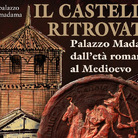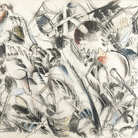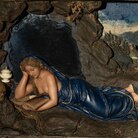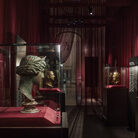Lucio Fontana. Terra e oro

Dal 22 May 2019 al 28 July 2019
Roma
Luogo: Galleria Borghese
Indirizzo: piazzale Scipione Borghese 5
Orari: dal martedì alla domenica, dalle 9.00 alle 19.00 (ultimo ingresso alle ore 17.00). Apertura serale ogni giovedì fino alle 21.00 (ultimo ingresso alle ore 19.00)
Curatori: Anna Coliva
Costo del biglietto: Intero € 18,00 + € 2,00 di prenotazione obbligatoria; Ridotto € 7,00 + € 2,00 di prenotazione obbligatoria
Telefono per prevendita: +39 06 32810
Sito ufficiale: http://www.galleriaborghese.it
La mostra Lucio Fontana. Terra e oro, a cura di Anna Coliva, è dedicata a due produzioni specifiche di Lucio Fontana, quella della ceramica e quella dei dipinti, selezionate rispettivamente nel tema delle Crocifissionie in quello dell’oro. Fontana è il primo artista italiano del Novecento esposto all’interno del Museo, dopo le rassegne dedicate a grandi figure quali Bacon, Giacometti, Picasso, per proseguire la serie di mostre concepite per accostare il visitatore alla conoscenza della Galleria Borghese con l’evidenza flagrante delle opere, e non solo con didascalie e illustrazioni.
Le opere sono circa cinquanta - realizzate principalmente nel decennio tra il 1958 e il 1968 – allestite in un percorso che coinvolge due sale nel piano delle sculture e sei sale nella galleria delle pitture.
La mostra si inserisce all’interno del progetto di ricerca su concetti cardine della collezione e del luogo. Fontana viene invitato a una relazione con la Galleria come soggetto in sé, in quanto propria e specifica figura artistica. Il Museo esprime spazi la cui percezione può continuamente rinnovarsi attraverso i modi della statuaria, delle superfici dipinte, dell’estensione del gusto collezionistico a configurazione dell’ambiente, tutti concetti che ricevettero radicale innovazione al suo interno con la nascita del Barocco e poi del Neoclassicismo, grazie alle complesse relazioni che vi si instaurano tra periodi diversi dell’evoluzione estetica.
A fissare gli occhi dello spettatore sulla genialità del luogo in quanto spazio, sull’importanza cognitiva di ogni singola invenzione dello spazio in opere come Amor Sacro e Amor Profanodi Tiziano, la Deposizionedi Raffaello, la Madonna dei Palafrenieridi Caravaggio, il Ritratto d’uomodi Antonello da Messina o la Melissadi Dosso Dossi e come le sculture di Gian Lorenzo Bernini, può essere chiamato solo il massimo innovatore dello spazionell’arte moderna: Lucio Fontana.
In un insieme straordinario di opere delle varie epoche lungo il percorso della storia dell’arte, dove lo spazio – sommo problema dell’arte figurativa dalle sue origini - è “rappresentato” nella maniera più varia e innovativa, solo Fontana è capace di dimostrare il raggiungimento finale della sua rappresentazione, perché Fontana lo spazio non lo rappresenta, lo crea. Egli supera radicalmente le rappresentazioni dello spazio che erano finzione spaziale, spazio “rappresentato”, e costruisce lo spazio nuovo.
Il luogo concreto del reale, quello in cui noi tutti viviamo e interagiamo con le opere, il nostro ambiente fisico, non è più contrapposto allo spazio ideale, in sé definito e altro, che è quello dell’opera d’arte, ma si unisce con esso attraverso le fenditure sulle tele. Il risultato di creare una dimensione altra è ancor più esaltato nei dipinti d’oro di Fontana, dove si fondono la fisicità del luogo in cui vive lo spettatore e quella dell’opera e dove essi acquisiscono l’ulteriore carattere metafisico, che l’oro significava nella pittura antica.
L’oro non è colore ma astrazione massima e antinaturalistica, ed è portato in un contesto, quello della Galleria Borghese, in cui la infinita varietà cromatica e la multiformità dei temi e dei soggetti penetra e informa di sé tutto lo spazio. Oro dunque non più nell’accezione barocca di massima esaltazione dell’ornamento, bensì vertice strutturale della forma che racchiude nella sua materia visivo-compositiva la luce stessa, nella sua interpretazione sinteticamente fisica ed estetica. Oro come componente che, al pari di quanto accade nell’antichità classica, paleocristiana, medievale e rinascimentale, è sintesi di luce e spazio.
Per rafforzare la rivoluzionaria relazione estetica e concettuale che la Galleria innesca con i Concetti spazialiin oro di Fontana si affianca, dalla sua produzione di ceramiche, una serie di Crocifissioni, tutte fortemente scosse da un fremito scomposto di origine ancora barocca e dove infatti l’idea spaziale è trattata ancora come “rappresentazione”, come avviene nelle opere classiche, non con la soluzione dirompente che avrà nei ‘buchi’ e nei ‘tagli’.
Al fine di rendere evidente la grande diversità fra la trattazione dello spazio nell’arte antica e la portata esplosiva della dimensione altra conquistata da Fontana con tagli e buchi, i dipinti moderni sono mescolati nell’allestimento della collezione permanente nella galleria delle pitture mentre le ceramiche sono esposte nel piano dedicato alla scultura in una prospettiva visuale che le staglia sui fondali del salone, assieme ai mosaici e ai marmi antico-romani e barocchi.
Il catalogo della mostra, edito da Silvana Editoriale, contiene un testo introduttivo di Anna Coliva e un saggio di Germano Celant.
SCARICA IL COMUNICATO IN PDF

-
 Dal 20 December 2025 al 20 April 2026
Caserta | Reggia di Caserta
Dal 20 December 2025 al 20 April 2026
Caserta | Reggia di Caserta
Regine: trame di cultura e diplomazia tra Napoli e l’Europa
-
 Dal 19 December 2025 al 23 March 2026
Torino | Palazzo Madama - Museo Civico d’Arte Antica
Dal 19 December 2025 al 23 March 2026
Torino | Palazzo Madama - Museo Civico d’Arte Antica
Il castello ritrovato. Palazzo Madama dall’età romana al medioevo
-
 Dal 17 December 2025 al 19 January 2026
Roma | Palazzo della Cancelleria
Dal 17 December 2025 al 19 January 2026
Roma | Palazzo della Cancelleria
De Humana Mensura di Linda Karshan
-
 Dal 18 December 2025 al 12 April 2026
Firenze | Gallerie degli Uffizi
Dal 18 December 2025 al 12 April 2026
Firenze | Gallerie degli Uffizi
Cera una volta. Sculture dalle collezioni medicee
-
 Dal 11 December 2025 al 9 April 2026
Firenze | Museo Archeologico Nazionale di Firenze
Dal 11 December 2025 al 9 April 2026
Firenze | Museo Archeologico Nazionale di Firenze
Icone di Potere e Bellezza
-
 Dal 11 December 2025 al 11 January 2026
Roma | Palazzo Esposizioni Roma
Dal 11 December 2025 al 11 January 2026
Roma | Palazzo Esposizioni Roma
Giorgio Morandi nella Collezione Eni. Un viaggio attraverso la storia culturale del cane a sei zampe e l’eredità di Enrico Mattei


